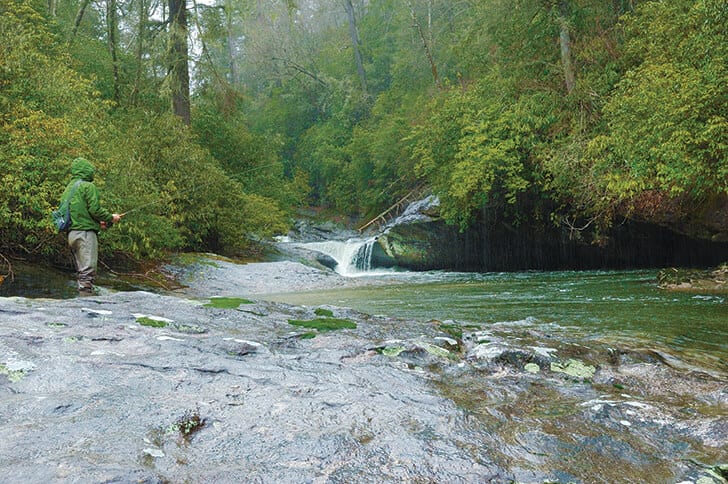Not many people know that much of the southern Appalachians are classified as a temperate rainforest. With average precipitation of about 60 inches a year, there is a swath of mountains from north Georgia up through western North Carolina and into east Tennessee that is a very wet place.
Those rainfall statistics might be hard to believe during drought years, when low flows and high summer temperatures leave southeastern trout lethargic in the lower elevations. But even on the hottest days, it is wet and cool in the lush creek bottoms of the high mountains. It’s what allows our wild trout, and our only native salmonid—the southern Appalachian brook trout—to thrive.
No one is thinking about low flows in spring, though. Creeks and rivers are usually full with heavy spring rains. The tailwaters are flush, sometimes blown out with dam releases. Flash floods are a dangerous possibility where small mountain creeks fall through their gorges. If you’re going fishing in the mountains this time of year, you better bring a rain jacket.
You should also make sure you bring your streamer box. Sure, we’re in the middle of some of the best dry fly action of the year. The Hendricksons, March browns, sulphurs, caddis, drakes and giant stones might all be flitting around right now. But when the sky grows dark and those first fat drops of rain begin to fall, take time to don your rain jacket and tie on something big and nasty. The fishing is getting ready to get mighty fun.
On multiple occasions, I’ve seen trout go absolutely bonkers in rising waters on the front end of a heavy rainstorm. All those raindrops are impending doom for the little crawling things that cling to rhododendron leaves. Flushed from the leaf litter or rolled out from the stones on the streambed, everything a trout likes to eat is stirred into the flow as the water rises and becomes stained.
Although the window of opportunity might be short, as the trout and the angler must both take cover at some point, the opening moments of a torrential downpour can be magical.
On the larger flows where there is the potential for large brown trout, bigger is better. I keep a few big, heavy, white Buggers in my box that only get wet when the water is rising. Those big bunny flies and articulated streamers you bought on a whim but never used? Now is the time to try them out.
Even on the smaller streams, rising water can spark a sub-surface feeding frenzy. Smaller streamers or double-nymph rigs with a big black stonefly as an anchor are both good options for fish that are frantic to gobble all the protein they can get while it is available.
Fishing in heavy rain requires the angler to use some common sense and not be literally carried away, though. Keep an eye on the conditions. Lightning is dangerous, as is rapidly rising water. Don’t put yourself in a situation you can’t get out of.
